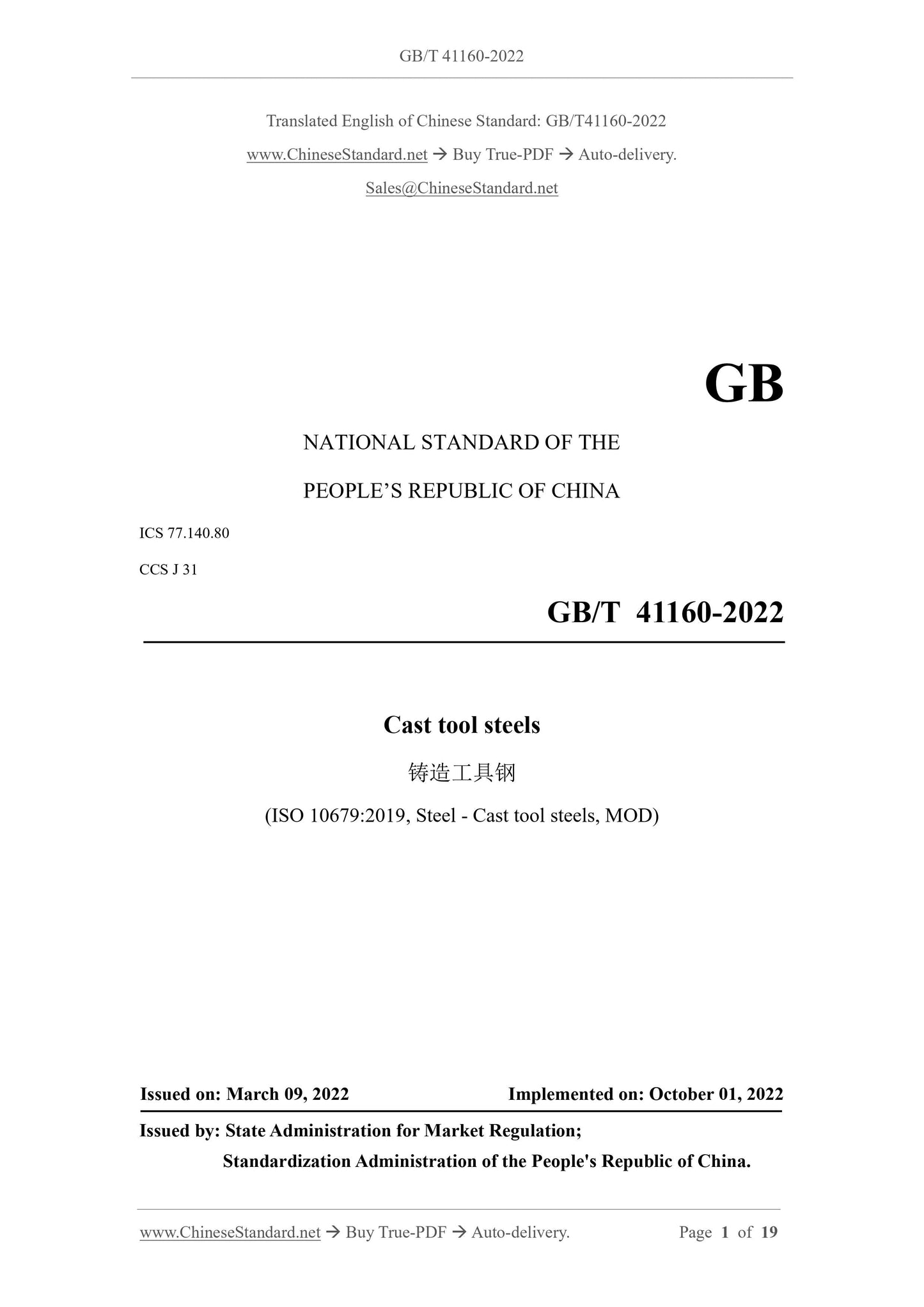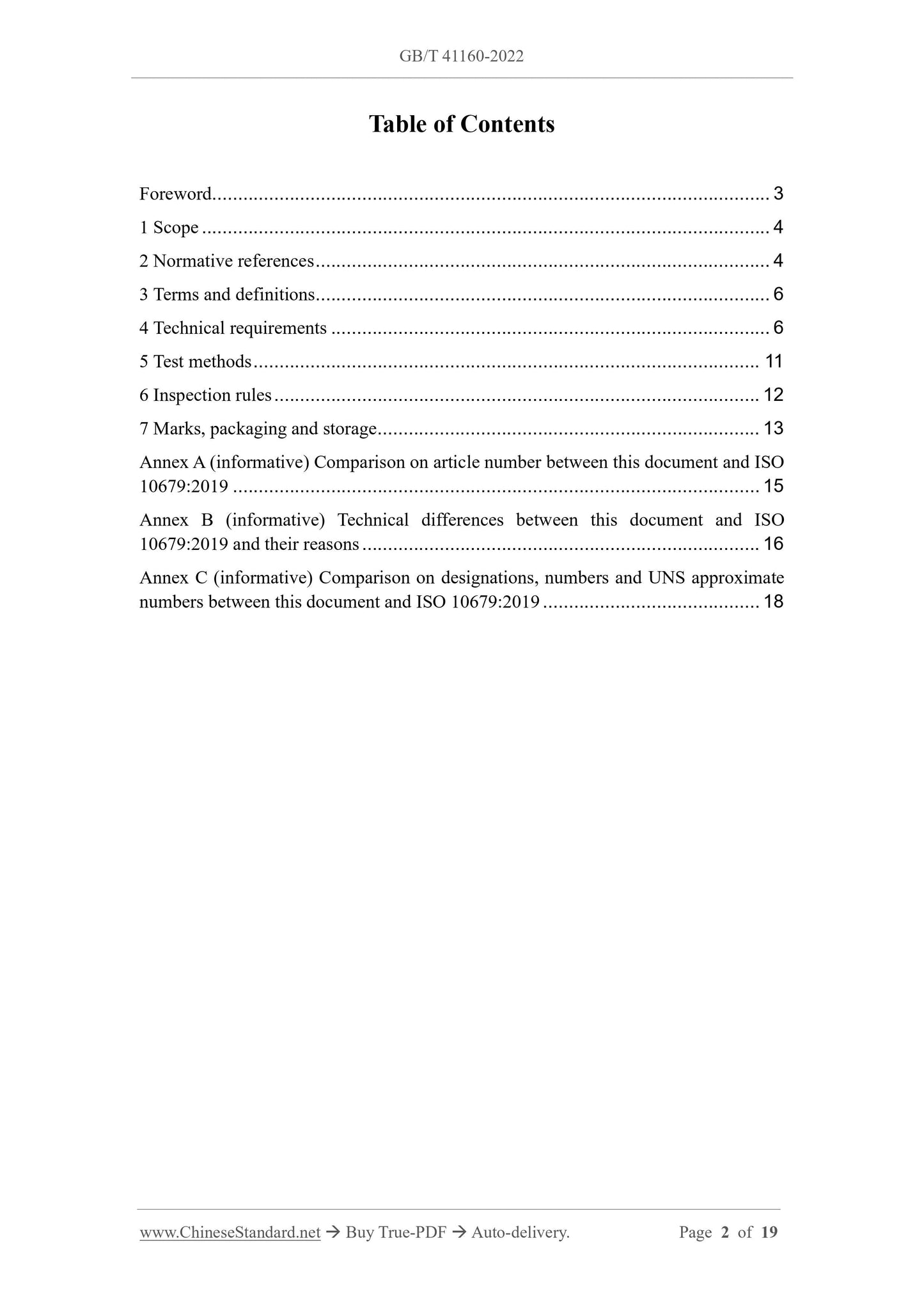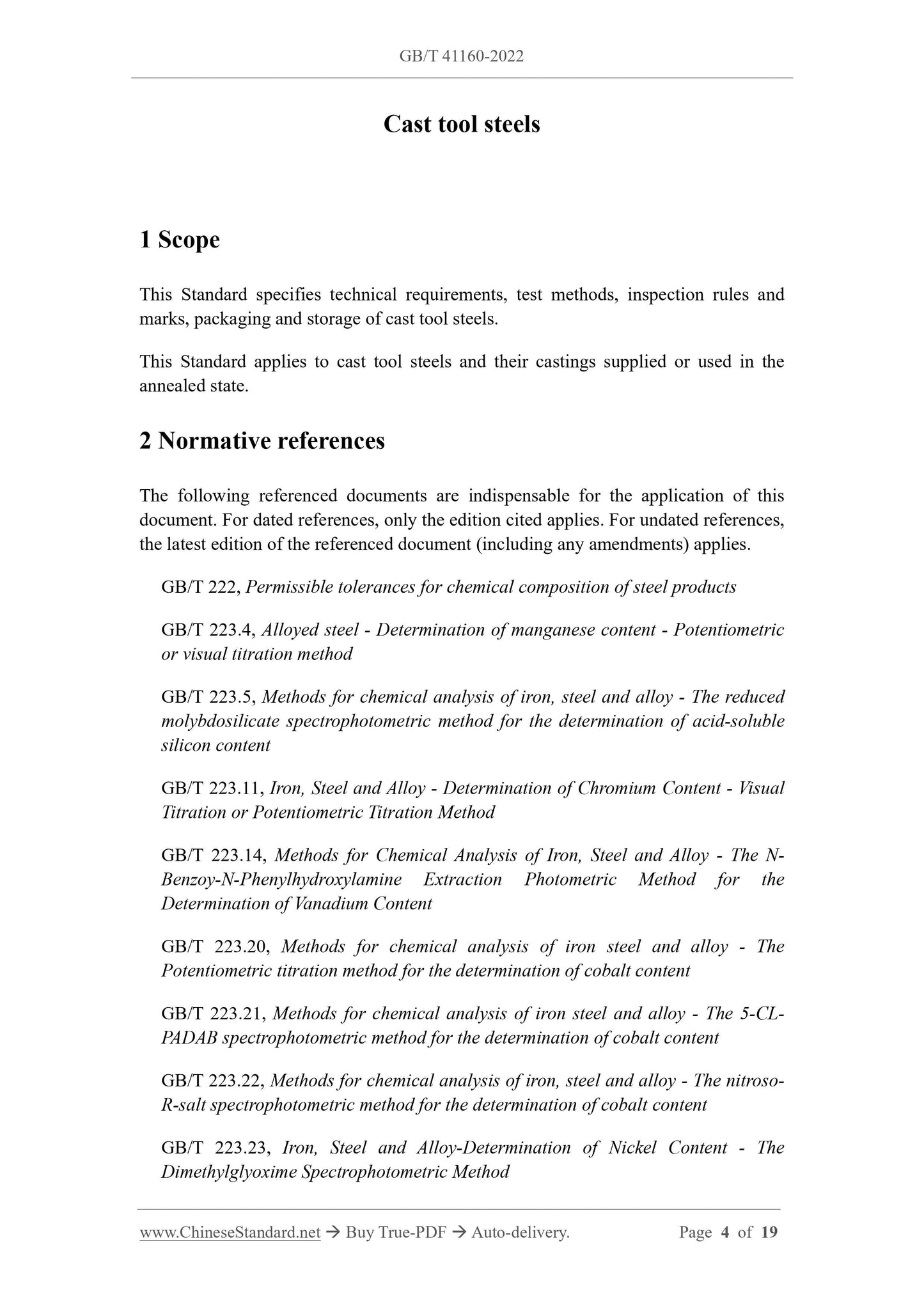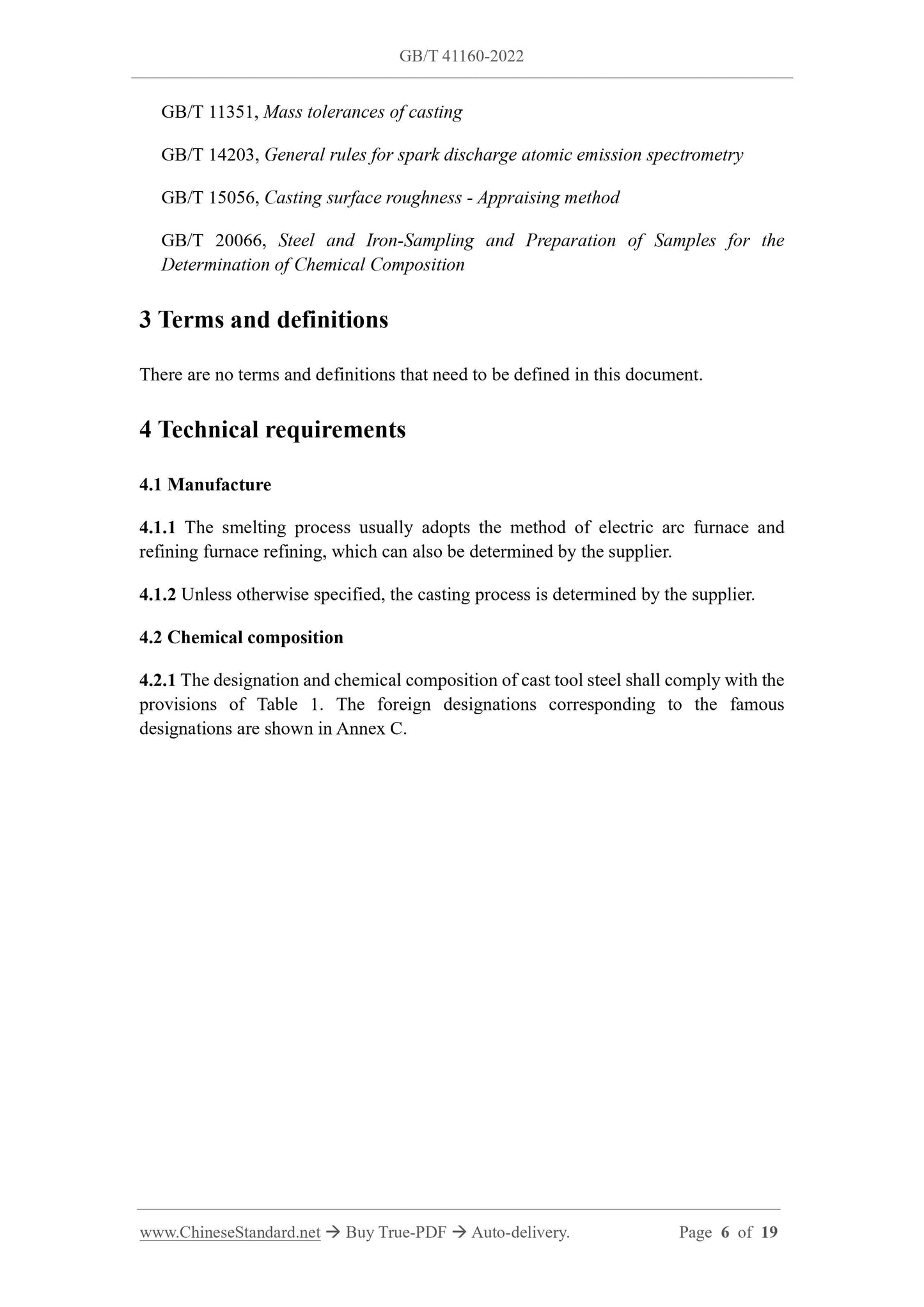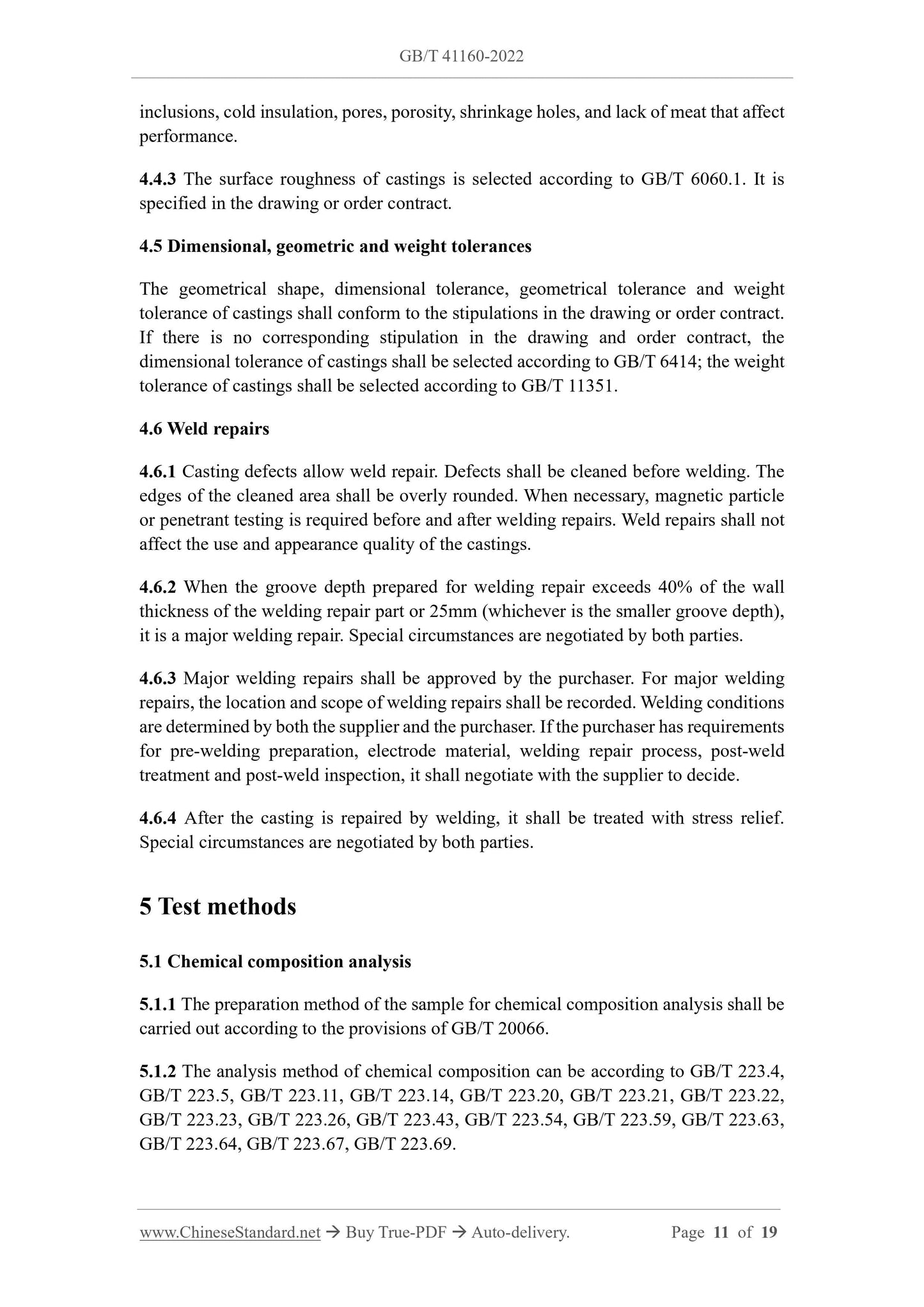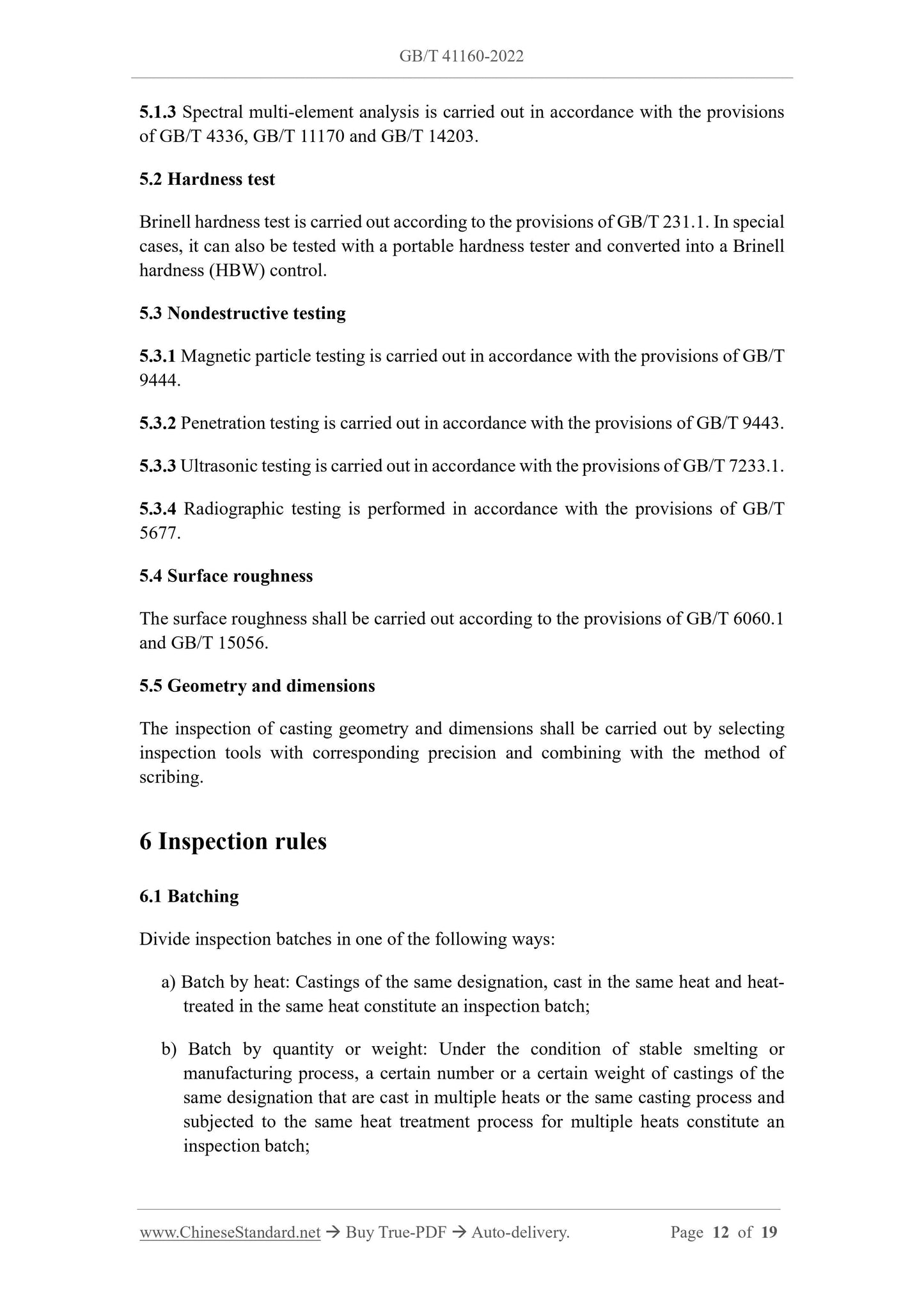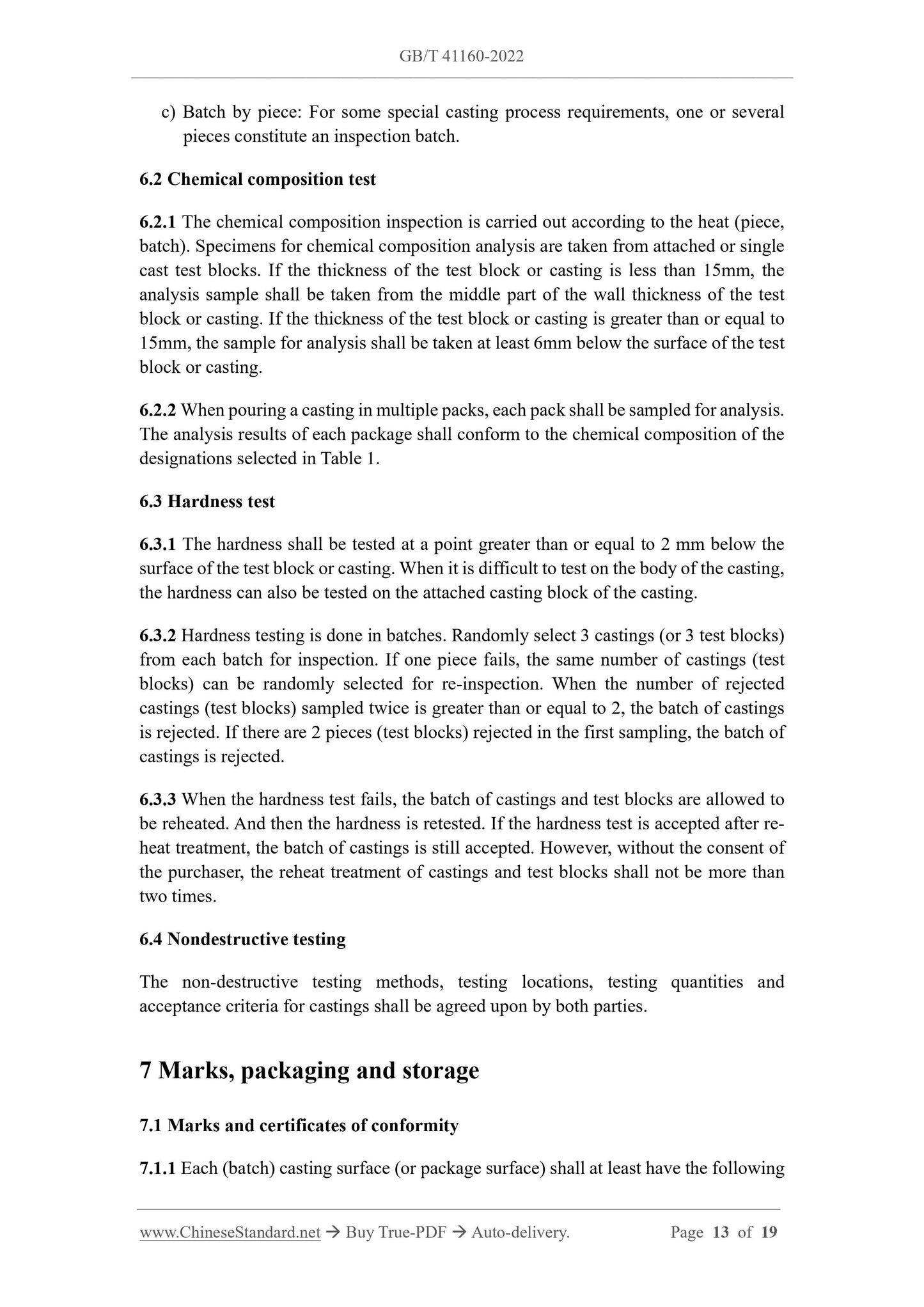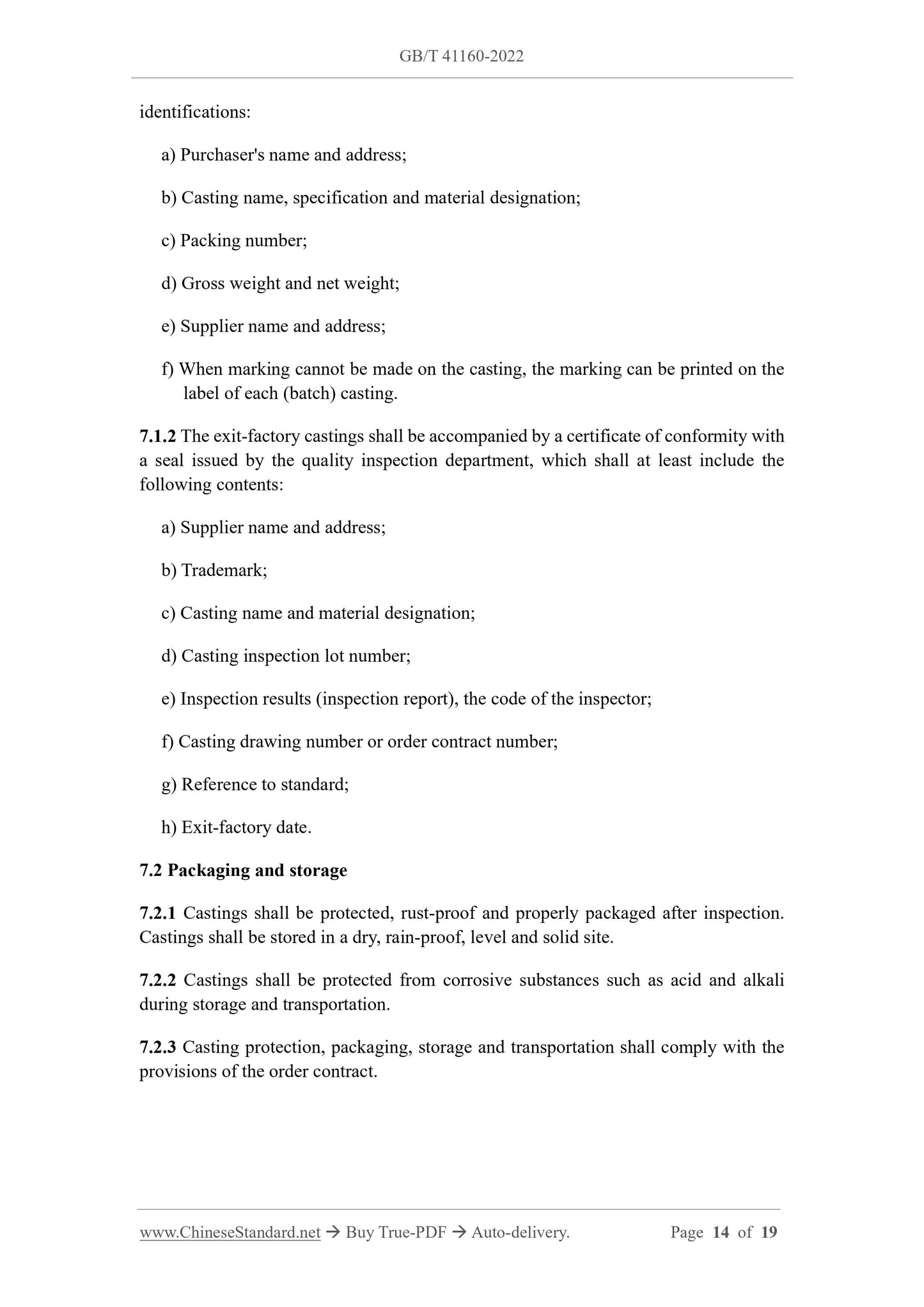1
/
of
8
PayPal, credit cards. Download editable-PDF and invoice in 1 second!
GB/T 41160-2022 English PDF (GBT41160-2022)
GB/T 41160-2022 English PDF (GBT41160-2022)
Regular price
$230.00 USD
Regular price
Sale price
$230.00 USD
Unit price
/
per
Shipping calculated at checkout.
Couldn't load pickup availability
Delivery: 3 seconds. Download true-PDF + Invoice.
Get QUOTATION in 1-minute: Click GB/T 41160-2022
Historical versions: GB/T 41160-2022
Preview True-PDF (Reload/Scroll if blank)
GB/T 41160-2022: Cast tool steels
GB/T 41160-2022
NATIONAL STANDARD OF THE
PEOPLE’S REPUBLIC OF CHINA
ICS 77.140.80
CCS J 31
Cast tool steels
(ISO 10679:2019, Steel - Cast tool steels, MOD)
ISSUED ON: MARCH 09, 2022
IMPLEMENTED ON: OCTOBER 01, 2022
Issued by: State Administration for Market Regulation;
Standardization Administration of the People's Republic of China.
Table of Contents
Foreword ... 3
1 Scope ... 4
2 Normative references ... 4
3 Terms and definitions... 6
4 Technical requirements ... 6
5 Test methods ... 11
6 Inspection rules ... 12
7 Marks, packaging and storage ... 13
Annex A (informative) Comparison on article number between this document and ISO
10679:2019 ... 15
Annex B (informative) Technical differences between this document and ISO
10679:2019 and their reasons ... 16
Annex C (informative) Comparison on designations, numbers and UNS approximate
numbers between this document and ISO 10679:2019 ... 18
Cast tool steels
1 Scope
This Standard specifies technical requirements, test methods, inspection rules and
marks, packaging and storage of cast tool steels.
This Standard applies to cast tool steels and their castings supplied or used in the
annealed state.
2 Normative references
The following referenced documents are indispensable for the application of this
document. For dated references, only the edition cited applies. For undated references,
the latest edition of the referenced document (including any amendments) applies.
GB/T 222, Permissible tolerances for chemical composition of steel products
GB/T 223.4, Alloyed steel - Determination of manganese content - Potentiometric
or visual titration method
GB/T 223.5, Methods for chemical analysis of iron, steel and alloy - The reduced
molybdosilicate spectrophotometric method for the determination of acid-soluble
silicon content
GB/T 223.11, Iron, Steel and Alloy - Determination of Chromium Content - Visual
Titration or Potentiometric Titration Method
GB/T 223.14, Methods for Chemical Analysis of Iron, Steel and Alloy - The N-
Benzoy-N-Phenylhydroxylamine Extraction Photometric Method for the
Determination of Vanadium Content
GB/T 223.20, Methods for chemical analysis of iron steel and alloy - The
Potentiometric titration method for the determination of cobalt content
GB/T 223.21, Methods for chemical analysis of iron steel and alloy - The 5-CL-
PADAB spectrophotometric method for the determination of cobalt content
GB/T 223.22, Methods for chemical analysis of iron, steel and alloy - The nitroso-
R-salt spectrophotometric method for the determination of cobalt content
GB/T 223.23, Iron, Steel and Alloy-Determination of Nickel Content - The
Dimethylglyoxime Spectrophotometric Method
GB/T 11351, Mass tolerances of casting
GB/T 14203, General rules for spark discharge atomic emission spectrometry
GB/T 15056, Casting surface roughness - Appraising method
GB/T 20066, Steel and Iron-Sampling and Preparation of Samples for the
Determination of Chemical Composition
3 Terms and definitions
There are no terms and definitions that need to be defined in this document.
4 Technical requirements
4.1 Manufacture
4.1.1 The smelting process usually adopts the method of electric arc furnace and
refining furnace refining, which can also be determined by the supplier.
4.1.2 Unless otherwise specified, the casting process is determined by the supplier.
4.2 Chemical composition
4.2.1 The designation and chemical composition of cast tool steel shall comply with the
provisions of Table 1. The foreign designations corresponding to the famous
designations are shown in Annex C.
inclusions, cold insulation, pores, porosity, shrinkage holes, and lack of meat that affect
performance.
4.4.3 The surface roughness of castings is selected according to GB/T 6060.1. It is
specified in the drawing or order contract.
4.5 Dimensional, geometric and weight tolerances
The geometrical shape, dimensional tolerance, geometrical tolerance and weight
tolerance of castings shall conform to the stipulations in the drawing or order contract.
If there is no corresponding stipulation in the drawing and order contract, the
dimensional tolerance of castings shall be selected according to GB/T 6414; the weight
tolerance of castings shall be selected according to GB/T 11351.
4.6 Weld repairs
4.6.1 Casting defects allow weld repair. Defects shall be cleaned before welding. The
edges of the cleaned area shall be overly rounded. When necessary, magnetic particle
or penetrant testing is required before and after welding repairs. Weld repairs shall not
affect the use and appearance quality of the castings.
4.6.2 When the groove depth prepared for welding repair exceeds 40% of the wall
thickness of the welding repair part or 25mm (whichever is the smaller groove depth),
it is a major welding repair. Special circumstances are negotiated by both parties.
4.6.3 Major welding repairs shall be approved by the purchaser. For major welding
repairs, the location and scope of welding repairs shall be recorded. Welding conditions
are determined by both the supplier and the purchaser. If the purchaser has requirements
for pre-welding preparation, electrode material, welding repair process, post-weld
treatment and post-weld inspection, it shall negotiate with the supplier to decide.
4.6.4 After the casting is repaired by welding, it shall be treated with stress relief.
Special circumstances are negotiated by both parties.
5 Test methods
5.1 Chemical composition analysis
5.1.1 The preparation method of the sample for chemical composition analysis shall be
carried out according to the provisions of GB/T 20066.
5.1.2 The analysis method of chemical composition can be according to GB/T 223.4,
GB/T 223.5, GB/T 223.11, GB/T 223.14, GB/T 223.20, GB/T 223.21, GB/T 223.22,
GB/T 223.23, GB/T 223.26, GB/T 223.43, GB/T 223.54, GB/T 223.59, GB/T 223.63,
GB/T 223.64, GB/T 223.67, GB/T 223.69.
5.1.3 Spectral multi-element analysis is carried out in accordance with the provisions
of GB/T 4336, GB/T 11170 and GB/T 14203.
5.2 Hardness test
Brinell hardness test is carried out according to the provisions of GB/T 231.1. In special
cases, it can also be tested with a portable hardness tester and converted into a Brinell
hardness (HBW) control.
5.3 Nondestructive testing
5.3.1 Magnetic particle testing is carried out in accordance with the provisions of GB/T
9444.
5.3.2 Penetration testing is carried out in accordance with the provisions of GB/T 9443.
5.3.3 Ultrasonic testing is carried out in accordance with the provisions of GB/T 7233.1.
5.3.4 Radiographic testing is performed in accordance with the provisions of GB/T
5677.
5.4 Surface roughness
The surface roughness shall be carried out according to the provisions of GB/T 6060.1
and GB/T 15056.
5.5 Geometry and dimensions
The inspection of casting geometry and dimensions shall be carried out by selecting
inspection tools with corresponding precision and combining with the method of
scribing.
6 Inspection rules
6.1 Batching
Divide inspection batches in one of the following ways:
a) Batch by heat: Castings of the same designation, cast in the same heat and heat-
treated in the same heat constitute an inspection batch;
b) Batch by quantity or weight: Under the condition of stable smelting or
manufacturing process, a certain number or a certain weight of castings of the
same designation that are cast in m...
Get QUOTATION in 1-minute: Click GB/T 41160-2022
Historical versions: GB/T 41160-2022
Preview True-PDF (Reload/Scroll if blank)
GB/T 41160-2022: Cast tool steels
GB/T 41160-2022
NATIONAL STANDARD OF THE
PEOPLE’S REPUBLIC OF CHINA
ICS 77.140.80
CCS J 31
Cast tool steels
(ISO 10679:2019, Steel - Cast tool steels, MOD)
ISSUED ON: MARCH 09, 2022
IMPLEMENTED ON: OCTOBER 01, 2022
Issued by: State Administration for Market Regulation;
Standardization Administration of the People's Republic of China.
Table of Contents
Foreword ... 3
1 Scope ... 4
2 Normative references ... 4
3 Terms and definitions... 6
4 Technical requirements ... 6
5 Test methods ... 11
6 Inspection rules ... 12
7 Marks, packaging and storage ... 13
Annex A (informative) Comparison on article number between this document and ISO
10679:2019 ... 15
Annex B (informative) Technical differences between this document and ISO
10679:2019 and their reasons ... 16
Annex C (informative) Comparison on designations, numbers and UNS approximate
numbers between this document and ISO 10679:2019 ... 18
Cast tool steels
1 Scope
This Standard specifies technical requirements, test methods, inspection rules and
marks, packaging and storage of cast tool steels.
This Standard applies to cast tool steels and their castings supplied or used in the
annealed state.
2 Normative references
The following referenced documents are indispensable for the application of this
document. For dated references, only the edition cited applies. For undated references,
the latest edition of the referenced document (including any amendments) applies.
GB/T 222, Permissible tolerances for chemical composition of steel products
GB/T 223.4, Alloyed steel - Determination of manganese content - Potentiometric
or visual titration method
GB/T 223.5, Methods for chemical analysis of iron, steel and alloy - The reduced
molybdosilicate spectrophotometric method for the determination of acid-soluble
silicon content
GB/T 223.11, Iron, Steel and Alloy - Determination of Chromium Content - Visual
Titration or Potentiometric Titration Method
GB/T 223.14, Methods for Chemical Analysis of Iron, Steel and Alloy - The N-
Benzoy-N-Phenylhydroxylamine Extraction Photometric Method for the
Determination of Vanadium Content
GB/T 223.20, Methods for chemical analysis of iron steel and alloy - The
Potentiometric titration method for the determination of cobalt content
GB/T 223.21, Methods for chemical analysis of iron steel and alloy - The 5-CL-
PADAB spectrophotometric method for the determination of cobalt content
GB/T 223.22, Methods for chemical analysis of iron, steel and alloy - The nitroso-
R-salt spectrophotometric method for the determination of cobalt content
GB/T 223.23, Iron, Steel and Alloy-Determination of Nickel Content - The
Dimethylglyoxime Spectrophotometric Method
GB/T 11351, Mass tolerances of casting
GB/T 14203, General rules for spark discharge atomic emission spectrometry
GB/T 15056, Casting surface roughness - Appraising method
GB/T 20066, Steel and Iron-Sampling and Preparation of Samples for the
Determination of Chemical Composition
3 Terms and definitions
There are no terms and definitions that need to be defined in this document.
4 Technical requirements
4.1 Manufacture
4.1.1 The smelting process usually adopts the method of electric arc furnace and
refining furnace refining, which can also be determined by the supplier.
4.1.2 Unless otherwise specified, the casting process is determined by the supplier.
4.2 Chemical composition
4.2.1 The designation and chemical composition of cast tool steel shall comply with the
provisions of Table 1. The foreign designations corresponding to the famous
designations are shown in Annex C.
inclusions, cold insulation, pores, porosity, shrinkage holes, and lack of meat that affect
performance.
4.4.3 The surface roughness of castings is selected according to GB/T 6060.1. It is
specified in the drawing or order contract.
4.5 Dimensional, geometric and weight tolerances
The geometrical shape, dimensional tolerance, geometrical tolerance and weight
tolerance of castings shall conform to the stipulations in the drawing or order contract.
If there is no corresponding stipulation in the drawing and order contract, the
dimensional tolerance of castings shall be selected according to GB/T 6414; the weight
tolerance of castings shall be selected according to GB/T 11351.
4.6 Weld repairs
4.6.1 Casting defects allow weld repair. Defects shall be cleaned before welding. The
edges of the cleaned area shall be overly rounded. When necessary, magnetic particle
or penetrant testing is required before and after welding repairs. Weld repairs shall not
affect the use and appearance quality of the castings.
4.6.2 When the groove depth prepared for welding repair exceeds 40% of the wall
thickness of the welding repair part or 25mm (whichever is the smaller groove depth),
it is a major welding repair. Special circumstances are negotiated by both parties.
4.6.3 Major welding repairs shall be approved by the purchaser. For major welding
repairs, the location and scope of welding repairs shall be recorded. Welding conditions
are determined by both the supplier and the purchaser. If the purchaser has requirements
for pre-welding preparation, electrode material, welding repair process, post-weld
treatment and post-weld inspection, it shall negotiate with the supplier to decide.
4.6.4 After the casting is repaired by welding, it shall be treated with stress relief.
Special circumstances are negotiated by both parties.
5 Test methods
5.1 Chemical composition analysis
5.1.1 The preparation method of the sample for chemical composition analysis shall be
carried out according to the provisions of GB/T 20066.
5.1.2 The analysis method of chemical composition can be according to GB/T 223.4,
GB/T 223.5, GB/T 223.11, GB/T 223.14, GB/T 223.20, GB/T 223.21, GB/T 223.22,
GB/T 223.23, GB/T 223.26, GB/T 223.43, GB/T 223.54, GB/T 223.59, GB/T 223.63,
GB/T 223.64, GB/T 223.67, GB/T 223.69.
5.1.3 Spectral multi-element analysis is carried out in accordance with the provisions
of GB/T 4336, GB/T 11170 and GB/T 14203.
5.2 Hardness test
Brinell hardness test is carried out according to the provisions of GB/T 231.1. In special
cases, it can also be tested with a portable hardness tester and converted into a Brinell
hardness (HBW) control.
5.3 Nondestructive testing
5.3.1 Magnetic particle testing is carried out in accordance with the provisions of GB/T
9444.
5.3.2 Penetration testing is carried out in accordance with the provisions of GB/T 9443.
5.3.3 Ultrasonic testing is carried out in accordance with the provisions of GB/T 7233.1.
5.3.4 Radiographic testing is performed in accordance with the provisions of GB/T
5677.
5.4 Surface roughness
The surface roughness shall be carried out according to the provisions of GB/T 6060.1
and GB/T 15056.
5.5 Geometry and dimensions
The inspection of casting geometry and dimensions shall be carried out by selecting
inspection tools with corresponding precision and combining with the method of
scribing.
6 Inspection rules
6.1 Batching
Divide inspection batches in one of the following ways:
a) Batch by heat: Castings of the same designation, cast in the same heat and heat-
treated in the same heat constitute an inspection batch;
b) Batch by quantity or weight: Under the condition of stable smelting or
manufacturing process, a certain number or a certain weight of castings of the
same designation that are cast in m...
Share
